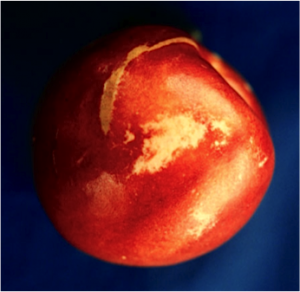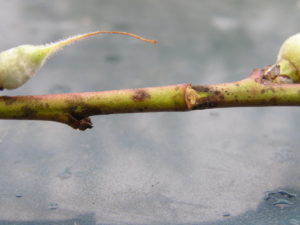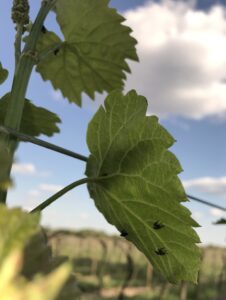Peach:
Bacterial Spot: Fruit symptoms from this set of infections have begun to appear in southern counties. So far fruit symptoms are very low and only in highly susceptible varieties. One of the few benefits of a dry spring dry spell is lower disease incidence. Peaches are close to pit hardening and at that point fruit will develop some resistance to bacterial spot. Infection s can still occur but will be less unsightly and may still make grade. Growers should continue to manage using Oxytetracyclene and lower rates of copper, especially around rainy periods and severe weather.
Oriental Fruit Moth: A biofix point for OFM was set on 4/10 in both northern and southern counties. All timings for first generation OFM have past.
| OFM 2nd Generation Timing | |||
| Insecticide Type | |||
| County/Region | Degree Days by 6/9 base 45 | Conventional
1150-1200 |
Diamide
1075-1150 |
| Gloucester – Southern | 888 | 1st –6/21-6/23
2nd – too far off |
1st –6/17-6/19
2nd – too far off |
| Middlesex – Northern | 862 | 1st –6/22-24
2nd – too far off |
1st –6/18-6/20
2nd – too far off |
Plum Curculio; Tarnished Plant Bugs; and Other Catfacing Insects: Plum Curculio start to move into orchards at about 88-100 degree days base 50 after January 1. Applications for PC should be initiated once all petals are off, with a second application made with ovicidal materials at 379-402 DD. Additional applications with effective materials may be made between 520 and 730 DD base 50. Currently we have accumulated about 702 DD base 50 in southern counties, and 630 DD base 50 in northern counties. Growers can monitor degree day development at their site by finding the nearest weather station and using the degree day development tool at NEWA. Catfacing insects are active, and activity is increasing with fry weather and summer temperatures. Very little recent fruit feeding has been observed.
Scale Insects: White peach scale crawlers should be at peak crawler emergence in southern counties. San jose scale crawlers began emergence about 5/31. SJS crawlers typically peak in mid-June and continue emergence for up to 6 weeks. Control options during crawler emergence include Neonicitiniods (suppression only), and the IGR’s Esteem and Centaur. See the NJ Commercial Tree Fruit Production Guide and the product labels for more information.
Thrips: If the current dry spell continues Flower Thrips may become an issue in highly colored ripening fruit, especially in poorly managed ground covers that contain clover or other flowering weeds. Thrips damage appears as “silvering” and usually appears on fruit close to harvest.
If populations are high damage can be extensive. Presence of thrips may be scouted for using a beating tray to detect the presence of adults and nymphs in the tree. Flowering weeeds and shrubs on orchard edges may also be scouted by shaking flowers onto a beating tray or a sheet of paper. Delegate or Entrust at the highest labeled rate are the usual recommended materials for thrips in stone fruit. Lannate may be effective in some orchards but has not worked well in recent years. These materials all have short PHI’s and may be applied close to harvest when damage typically appears. Thrips have also been observed to mark cherries. Damage is different than peach and appears as a dark streak in a similar pattern as silvering. See the NJ Commercial Tree Fruit Production Guide for more information.
Apples and Pears:
Diseases: Now that primary scab has ended, the focus turns toward summer diseases such as fruit rots (esp. Bitter rot), and sooty blotch and fly speck. Bitter rot control has been difficult at best in recent years even where management programs have been rigorous. Research has suggested products such as Merivon, Luna Sensation and Inspire Super may be effective, and longtime reliable broad spectrum fungicides such as captan and ziram should provide control. Experience has suggested that the addition of phosphorous acid products such as Prophyt or Rampart to captan sprays may improve control. Observations are that these products improve control of other summer diseases such as sooty blotch and flyspeck, and may help suppress scab infections where present.
Fire Blight: Fire Blight symptoms began appearing in southern county apple and pear orchards the week of 5/1. Typically it is recommended to cut out infected limbs however this is a practical decision that must be made. This blog post from Michigan State may be helpful to decide whether it is worth cutting out infected tissue. Once the terminal buds set, typically in July, infected wood should be removed to prevent colonization by the bitter rot pathogen.
Codling Moth (CM): The first codling moth flight has started. A biofix was set for CM on April 17th in both northern and southern counties. Trap captures began increasing again in southern counties this week. Timings are updated below.
| Codling Moth Degree Day Timing | ||||||||
| Application and Insecticide Type | ||||||||
| County Area | Biofix | Rimon:
75-100DD + 14-17 days later
|
Intrepid
150 + 450 DD Diamides – Altacor, Voliam mixes: (150-200 DD) |
Cyd-X, Carpovirusine
250 DD + every 7-9 days during brood hatch (later if first spray is an IGR) |
Standard Insecticides – Delegate, Avaunt, OP’s, carbamates, pyrethroids
250 DD + 550 DD
|
|||
| DD | 75 | 100 | 150 | 450 | 250 | 250 | 550 | |
| Southern | April 17 | past | past | past | 6/7 | past | past | 6/11 |
| Northern | April 17 | past | past | past | 6/8 | past | past | 6/13 |
Tufted Apple Budmoth (TABM): A biofix for TABM was set in southern county orchards on 5/8. Nothing needs to be done for TABM at this point. The first alternate middle applications for TABM will be on or about 6/12 in southern counties. This has been considered a minor pest in recent years. Many materials used for Codling Moth will also control TABM.
Pear: Second generation pear psylla began hatching about 5/15. Options for control include spynosyn products such as Delegate and Entrust, and the neocitinoids (IRAC group 4A). The addition of 0.25-1 gal of summer oil may improve control. Other options include Movento, the IGR’s Esteem and Centaur, and products containing abamectin. Be sure to read and follow the label instructions regarding the addition of penetrants for abamectin products. Pear Psylla are still actively laying eggs and nymphs continue to hatch.
Grape: Early blooming native grapes were at 50% bloom on 5/24, therefore we have set the the Grape Berry Moth biofix at 5/24 for southern counties. Typically we would use the bloom date for V. riparia to set the biofix date, however the usual locations we have used in the past did not have viable vines to look at, and it is difficult to scout new locations for V. riparia this year. Since V. riparia typically blooms with early natives we used Concord and Ives to set the biofix. The model works best when growers record their own bloom dates and use the Grape Berry Moth model at NEWA. Applications for GBM using Intrepid or Diamides should be made at 810 DD base 47. Other effective materials can be applied a few days later. Currently we are at 167 DD in southern counties. Applications have been historically made around the end of June in southern counties.
Tree Fruit Trap Captures – Southern Counties
| STLM | TABM-A | CM | BMSB | OFM-A | DWB | OFM-P | TABM-P | LPTB | PTB | |
| 4/15/2023 | 433 | 20 | 1 | |||||||
| 4/23/2023 | 423 | 1 | 13 | 8 | 4 | |||||
| 4/30/2023 | 417 | 7 | 15 | 4 | 1 | 0 | ||||
| 5/06/2023 | 9 | 2 | 3 | 1 | 0 | 0 | ||||
| 5/13/2023 | 18 | 2 | 7 | 2 | 3 | 0 | 6 | 6 | ||
| 5/20/2023 | 5 | 18 | 6 | 0 | 51 | 0 | 13 | 67 | ||
| 5/27/2023 | 1 | 11 | 4 | 0 | 17 | 0 | 11 | 49 | ||
| 6/03/23 | 3 | 8 | 2 | 1 | 24 | 0 | 13 | 65 |
Tree Fruit Trap Captures – Northern Counties
| STLM | TABM-A | CM | BMSB | OFM-A | DWB | OFM-P | TABM-P | LPTB | PTB | |
| 4/8/2023 | 10 | |||||||||
| 4/15/2023 | 20 | 3 | ||||||||
| 4/30/2023 | 28 | 11 | 6 | |||||||
| 5/06/2023 | 22 | 2 | 19 | 9 | ||||||
| 5/13/2023 | 34 | 1 | 3 | 2 | 5 | 0 | ||||
| 5/20/2023 | 31 | 6 | 7 | 1 | 6 | 0 | ||||
| 5/27/23 | 16 | 18 | 4 | 1 | 17 | 3 | 11 | |||
| 6/03/23 | 12 | 26 | 2 | 0 | 17 | 2 | 12 |
Phenology Table: Based on annual observations made in Gloucester County.
| Pest Event or Growth Stage | Approximate Date | 2023 Observed Date |
| Bud Swell (Redhaven) | March 23 +/- 15 Days | March 7 |
| 1/4″ Green Tip Red Delicious | March 31 +/- 13 Days | March 27 |
| Pink Peach (Redhaven) | April 4 +/- 15 Days | March 24 |
| Tight Cluster Red Delicious | April 9 +/- 13 Days | April 7 |
| Full Bloom Peach (Redhaven) | April 9 +/- 14 Days | April 4 |
| Pink Apple (Red Delicious) | April 14 +/- 12 Days | April 11 |
| Full Bloom Apple (Red Delicious) | April 22 +/- 11 Days | April 16 |
| Petal Fall (Redhaven) | April 22 +/- 10 Days | April 15 |
| Petal Fall (Red Delicious) | April 27 +/- 13 Days | May 3 |
| Shuck Split (Redhaven) | April 30 +/- 11 Days | April 21 |
| Pit Hardening | June 15 +/- 9 Days |



